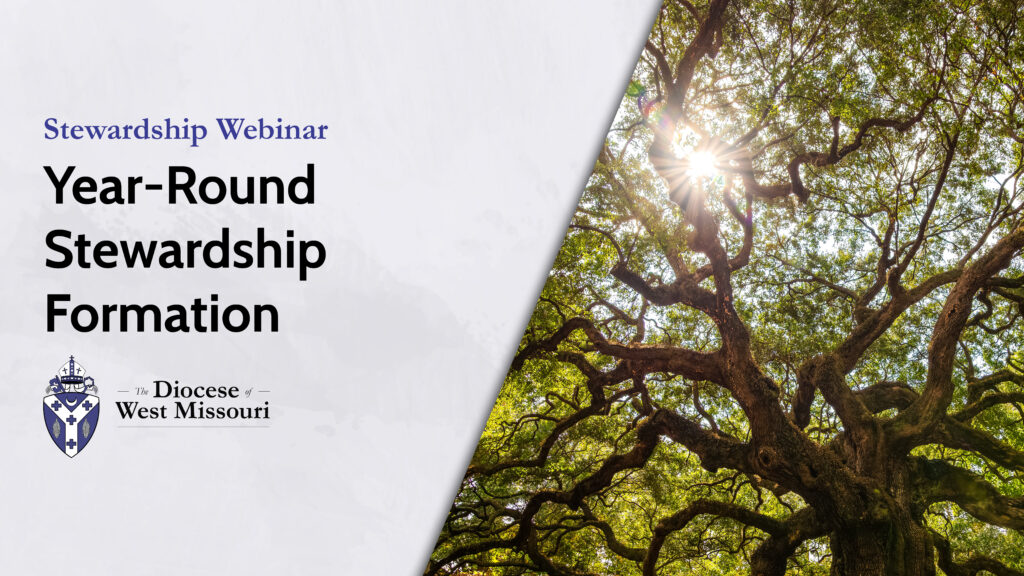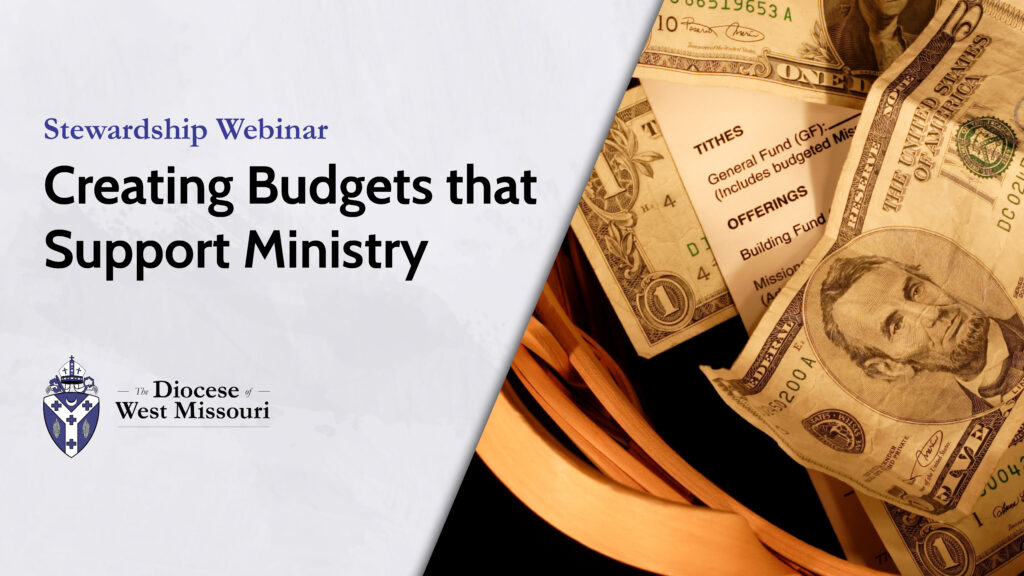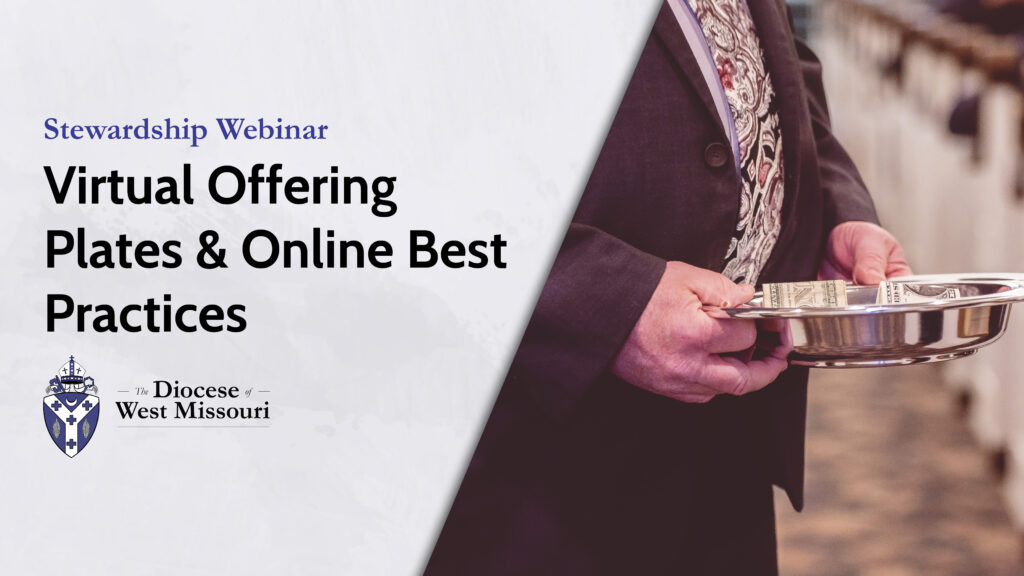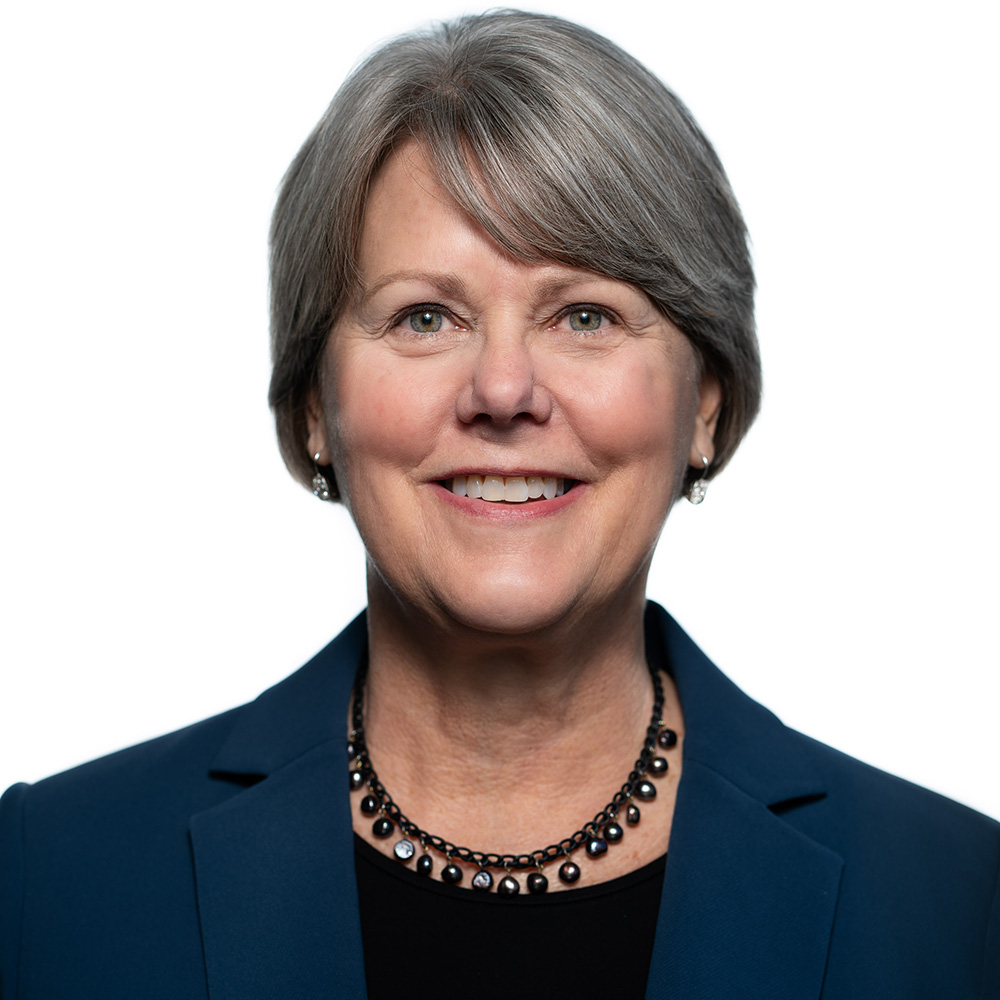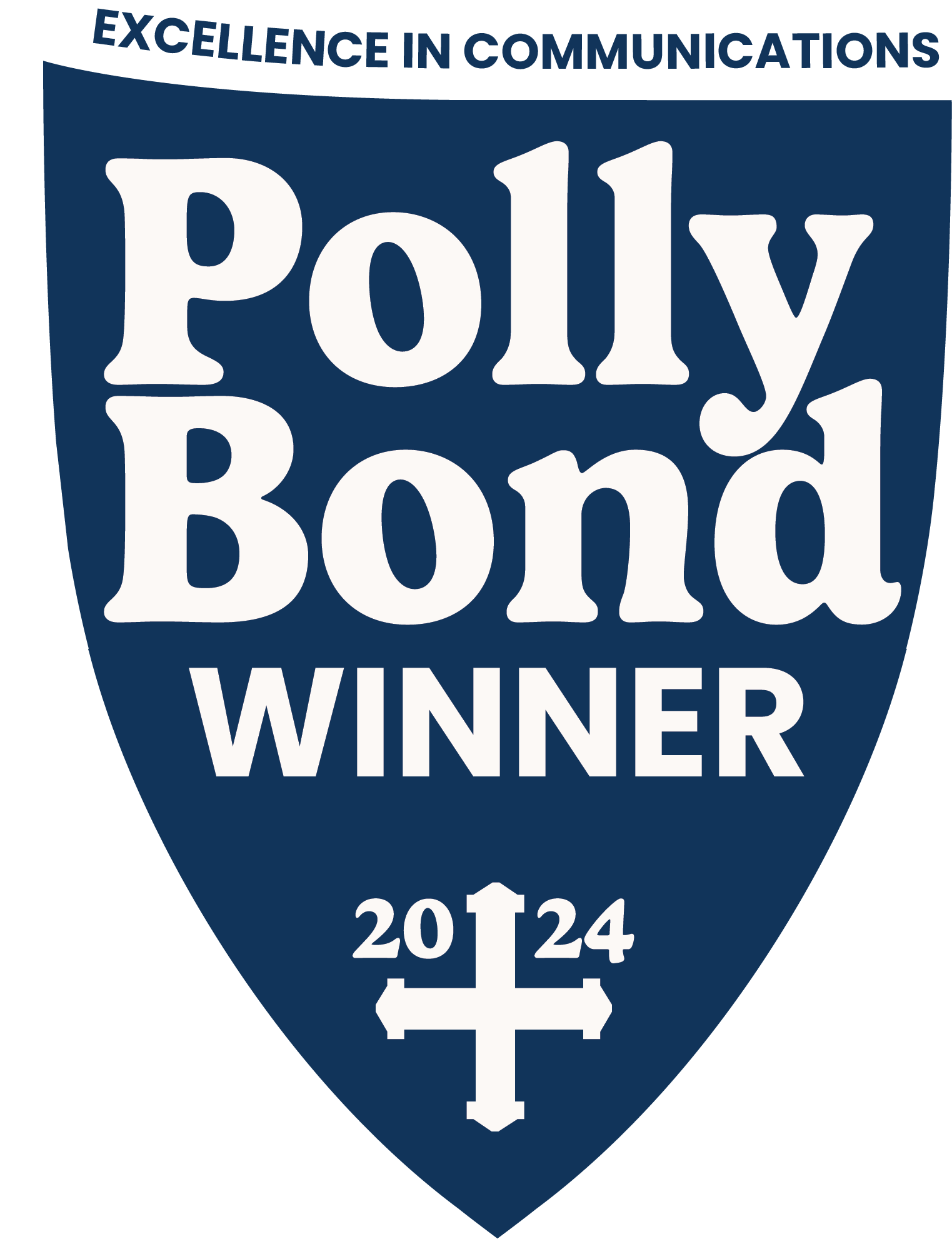The Stewardship Commission supports churches in the diocese with all types of stewardship: year-round, annual, major gift, campaigns, and planned giving. Our overarching goal is to see a revitalized emphasis on holistic stewardship in each church. Below you’ll find shared resources between the churches of West Missouri to support their mission and ministries.
Annual Giving Programs
Even when the annual giving program works well, churches might consider changing it up about every three years so everyone participating experiences God’s call in a new and engaging way.
Here are some best practices to consider as you plan your annual campaign:
- Be strategic in building the team
- Communicate the budget through mission and ministry
- Stress givers joy rather need to receive
- Structure your campaign to acknowledge different giving patterns
For more ideas and resources about the annual campaign:
TENS — The Episcopal Network for Stewardship
The Diocese of West Missouri is a member of The Episcopal Network for Stewardship (TENS) and all parishes have access to the materials on their website. They provide annual campaign themes and materials each year, webinars, and a resource library. If your church does not have a record of the password needed to access TENS, please contact the Bishop’s Assistant.

Project Resource
Sponsored by the College of Bishops, the Project Resource seminars provide overall fundraising training for clergy and laypersons. Teams from parishes are encouraged to participate together in preparation for year-round stewardship. It is grounded in the theology of stewardship, provides excellent materials, and year-round support.

New Consecration Sunday
New Consecration Sunday (NCS) is based on the biblical philosophy of the need of the giver to give for his or her own spiritual development. It is a 4-week program with a guest leader, letters to the parish, speakers, step up/giving chart, leadership meal, and celebration meal. The book and CD include all the plans, letters, and articles. The book is available on Amazon.
Additional Stewardship Resources
If you’re looking for additional resources or ideas on how you can grow your ministry, download the PDF for a full list of recommended resources that can help you achieve your Stewardship goals.
Planned Giving
Planned gifts provide a wonderful way for parishioners to express their generosity, make a difference by furthering our mission, and provide themselves with valuable tax and income benefits. It is the ultimate gift to share our heartfelt faith in Christ.
The Episcopal Church Foundation has excellent resources for your congregations to use for planned giving, endowment management, and donor-advised funds.
The brochures listed below are available for purchase through Forward Movement. The item number is included below as well as a PDF of the brochure.
- Planned Giving: Stewards of God’s Bounty (Forward Movement Product number: #2082)
- Charitable Gift Annuity: Guarantee an Income for Life (Forward Movement Product number: #2083)
- Charitable Remainder Trust: Help Loved Ones and the Church (Forward Movement Product number: #2084)
- Pooled Income Fund: Give and You Shall Receive (Forward Movement Product number: #2085)
- Writing Your Will: Where There’s A Will There’s A Way (Forward Movement Product number: #2086)
Additional Congregational Resources for Planned Giving
Stewardship Commission members are available for consultation as well as providing presentations and materials:
- The Ultimate Gift: Christian Witness at Death – presentation for parishioners on planning for end of life, your will, and ways to give.
- Gift Planning Program – how to encourage planned gifts through an organized approach.
- Endowment Management – organize and grow your endowment.
Electronic Giving
Donors who give electronically, especially when they make recurring gifts, often give more than those using checks or cash.
Share information about electronic giving in your bulletins, enewsletters, and website. Take every opportunity to share the link or QR code.
There are many platforms available to you, along with information about several platforms widely used by churches.
Advantages:
- Security
- Convenience
- Attractive to younger generation
- Good for the environment
- Simplifies bookkeeping
- Stabilize the church’s cash flow
- Increase in actual revenue received
- First Fruits
If your church already has a PayPal account, but you don’t know how to add a donate button, we can help you do it.
For more information contact the Communications Director or call 816-471-6161 ext. 111.
Promoting Year-Round Stewardship
Year-round Stewardship is an opportunity to teach about stewardship and to develop and celebrate the various ministries within the parish, as well as to encourage the church’s outreach to its wider community. A variety of activities separate from the fall pledge campaign can provide stewardship education and bolster the idea of giving not only money but also the time and talent without which our parishes cannot function. They may even result in extra general monetary donations in addition to gifts for specific causes.
Stewardship education is key. Possible steps include the following:
- Boxes in the weekly service bulletin or announcements sheet promoting good stewardship of all God’s gifts.
- Regular short (not over three minutes) testimonials (on why they give/share their talents/appreciate the parish) or readings of short articles by members of the Stewardship Committee or volunteers within the church (monthly and/or connected to special events or seasons.)
- Regular articles in the parish newsletter promoting various aspects of stewardship, perhaps tied to Biblical quotations.
- Regular articles in the parish newsletter which explain what a committee (such as Outreach, Evangelism or Green Team) is doing or has done recently, and how others can participate.
- Articles, bulletin notes, or announcements inviting parishioners to bring specific kinds of donations (socks, easy-to-open foods for children, etc.) for those in need or to practice an environmentally-friendly habit.
- Green tips in the newsletter, perhaps just a short paragraph and possibly a cartoon.
- Thank-you mentions (not necessarily by individual names) noting contributions of time and talent (such as a clean-out of kitchen cabinets, flower bed planting and maintenance, other yard work, Altar Guild cleaning days or their regular weekly work, cooking and clean-up for parish dinners or after-funeral receptions.)
- Presentations by an attorney or other professional on wills, trusts, Durable Powers of Attorney and Durable Powers of Attorney for Health Care.
- Presentations and events to provide information about and to encourage planned giving Formation of a Legacy Society and an annual event to thank those who are members. (Note: some members may not want this aspect of their estate plan to be public.) Touching base with members in the time of COVID, or with those who are not able to come to a dinner or other Society event, can be as simple as notes and perhaps a hand-delivered tin of commercially-baked cookies at Christmas.)
- Use of the parish website, Facebook page, etc. to convey timely information about the concept of stewardship, activities, opportunities, and accomplishments.
Sermons and hard-copy mailings may be used primarily with a fall pledge campaign, but they can also be helpful in conjunction with some of the items mentioned above.
Timely thank-you letters or notes are crucial after a financial pledge is received, but that isn’t the only occasion when expressions of appreciation are important.
TENS led a Stewardship webinar about annual stewardship campaigns. Head to the TENS website to download the materials and view the video.
Elements of a Church Capital Campaign
1. Planning & Visioning
Are the needs you have identified consistent with the congregation’s future vision of the church?
Formulate the questions that need to be answered by the congregation.
Provide a forum for all members to discuss, compile the responses, give members opportunity to prioritize the responses, and communicate the priorities to the congregation.
Case Statement – the communication toolbox that includes the opportunity, vision, method & plan, plans for fundraising, urgency all on one page.
2. Goal Setting
Consider most campaigns plan for three-year commitments from donors.
Campaigns that use outside consultants generally can achieve higher goals.
Do it yourself campaigns generally raise an average of 50% of annual giving.
3. Project Implementation Plans
Detailed plans of how to implement the planned project or projects that will be funded by the campaign. Regular communication with the parish about the project will be important.
4. Fundraising Feasibility Study
Through interviews and surveys your members will give feedback on the campaign goals established and determine the congregation’s level of commitment and uncover any dissatisfaction with the process.
5. Capital Campaign
Process allows prayer, involvement, and communication. The feasibility study and the campaign itself will take approximately four months. Involving the congregation in a variety of activities prior to asking for a financial commitment is essential to building trust and obtaining a commitment to the project.
Members
- Zella Forsythe
- Beth Kang
- Jane Lampo
- The Rev. Isaac Petty Pierjok
- Anita Philbrick
- Linda Robertson
- The Rev. Ryan Williams


